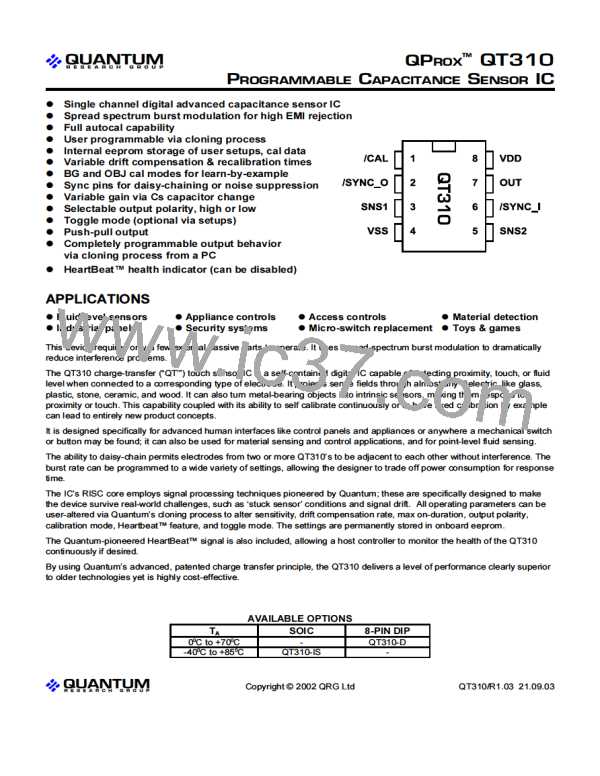Toggle Latch Mode cannot be used with BG2 or OBJ modes,
as /CAL_CLR must be used as a calibrate input in these two
modes (Sections 1.6, 2.8.4, 2.8.5).
2.8.2 SENSE
DIRECTION (SD)
OPTIONS: POS OR
N
EG;
D
EFAULT
: POSITIVE
The programmable SD option controls whether the device
responds to increases in Cx (‘normal’ detection) or decreases
in Cx (‘absence’ detection). The default mode is positive.
2.7.4 HEART
B
EAT™ OUTPUT (HB)
Default: Enabled
Setup: Enable/Disable;
The OUT pin can have HeartBeat™ ‘health’ indicator pulses
superimposed on it. This operates by floating the 'OUT' pin for
approximately 15µs before each burst.
2.8.2.1 Positive Sense Direction (default)
This is the normal mode of operation for touch sensing.
Calibration is normally done when an object is not present;
OUT becomes active if an object approaches.
Heartbeat can be used to determine if the sensor is operating
properly. The frequency of the floats can be used to see if the
IC is operating within desired limits. The Heartbeat signal can
be tested by connecting a 10K resistor to OUT that is toggled
by a microcontroller depending on the logic level of OUT.
In this configuration, if Cx increases enough the internal
signal will pass the threshold level, and OUT will become
active. Cx must fall again so the internal signal traverses the
hysteresis level for OUT to become inactive.
Heartbeat pulses can be removed simply by placing a
capacitor on the OUT pin; if OUT is loaded into a high-
impedance CMOS input or MOSFET, this is usually enough.
The threshold and hysteresis levels are set relative to the
reference level determined during calibration.
2.8.2.2 Negative Sense Direction
It is possible to disable HeartBeat provided SC is set to zero,
by setting the HB control bit to '1'. Otherwise, the Heartbeat
signal is always enabled.
In this mode, if the part is made to calibrate when an object is
present, OUT will become active if the object departs (Cx
decreases).
In this configuration, if Cx decreases enough the internal
signal will pass the threshold level, and OUT will become
active. Cx must rise again so the internal signal traverses the
hysteresis level for OUT to become inactive.
2.7.5 OUTPUT
D
RIVE
C
The OUT pin is a push-pull CMOS type.
APABILITY
OUT can source or sink up to 2mA of non-inductive current. If
an inductive load is used, such as a small relay, the load
should be diode-clamped to prevent damage. The current
must be limited to 2mA max continuous to prevent detection
side effects from occurring, which happens when the load
current creates voltage drops on the die and bonding wires;
these small shifts can materially influence the signal level to
cause detection instability.
The threshold and hysteresis levels are set relative to the
reference level determined during calibration.
2.8.3 DETECT
M
ODE (DM) SELECTION
O
PTIONS: BG OR OBJ; EFAULT: BG
D
The IC can be set to calibrate and detect in one of two
different modes to suit the application. The selection is made
using the cloning process.
2.8 DETECTION MODES
SD - Sense Direction: Pos or Neg; Default: Positive
The device default is BG. There are two BG modes, BG1 and
BG2, which must be further selected as described below. The
BG mode default is BG1.
DM - Detect Mode: BG or OBJ;
BG - BG Mode: BG1 or BG2;
Default: BG
Default: BG1
It is possible to change the basic way the device detects and
operates via the cloning process as described below. In
particular, it is possible to determine whether the device
responds to increases in Cx (‘normal’ detection) or decreases
in Cx (‘absence’ detection). It is also possible to change how
the device calibrates itself, in one of three possible modes.
OBJ mode is described in Section 2.8.5.
2.8.4 BG (BACKGROUND) DETECTION
M
ODES
O
PTIONS: BG1 OR BG2; EFAULT: BG
D
1
The BG modes are useful when it is easier to calibrate on the
baseline signal level than the signal from the object to be
detected. The detection is always made relative to this
reference level, and the sensitivity is governed by the
adjustable threshold level (as well as capacitor Cs, and load
Cx). The BG modes are generally easier to use than OBJ.
2.8.1 SIGNAL
D
EFINITIONS
Increasing Cx load on the electrode will result in a shorter
burst length. Since internal computations are based on burst
length, a shorter burst length means a smaller internal signal
number; conversely, a longer burst length means less Cx but
higher internal signal numbers. In summary:
There are two BG modes, BG1 and BG2. In these modes,
threshold and hysteresis values are calculated relative to the
reference level, which in turn is determined during calibration.
The two modes differ in that BG1 mode the calibration is
volatile whereas in BG2 mode the calibration reference is
stored in eeprom and reused until the next calibration.
Cx rises ꢀ shorter Burst Length ꢀ less internal signal
Cx drops ꢀ longer Burst Length ꢀ more internal signal
These relationships, are important to understand to avoid
confusion. They mirror signal values shown in QT3View and
the burst length as viewed on an oscilloscope.
Hysteresis can be altered as per Section 2.4.
Sense direction (SD) behavior: In both BG modes OUT can
be made active on either positive or negative Cx changes
(Section 2.8.2). SD selection affects which side of the
reference the threshold and hysteresis points are placed.
LQ
9
QT310/R1.03 21.09.03

 QUANTUM [ QUANTUM RESEARCH GROUP ]
QUANTUM [ QUANTUM RESEARCH GROUP ]